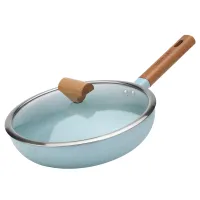Is Carbon Steel Frying Pan Safe for Cooking?
The choice of cookware plays a crucial role in the overall cooking experience, and carbon steel frying pans have gained popularity for their impressive heat conductivity, durability, and versatility. While carbon steel pans are generally safe for cooking, understanding the nuances of their usage, maintenance, and potential concerns is essential for ensuring both safety and optimal performance.
1. Seasoning for Non-Stick Properties
One of the distinctive features of carbon steel frying pans is their need for seasoning before use. Seasoning involves applying a thin layer of oil to the pan's surface and heating it, creating a natural non-stick coating. This process not only enhances the cooking performance but also forms a protective barrier that prevents the leaching of iron into the food. Proper seasoning is crucial for both the safety and functionality of the pan.
2. Avoiding Acidic Foods
While carbon steel is generally considered safe for cooking, it is recommended to exercise caution with highly acidic foods. Prolonged exposure to ingredients like tomatoes or citrus can lead to a reaction with the metal, potentially affecting the flavor of the dish. To maintain the safety and integrity of the pan, it is advisable to limit the use of highly acidic ingredients or employ alternative cookware for such recipes.

3. Proper Cleaning and Maintenance
Maintaining the safety and effectiveness of a carbon steel frying pan requires proper cleaning and maintenance. Unlike some other materials, carbon steel cookwares should not be cleaned in a dishwasher or with harsh detergents. Instead, hand wash the pan with a soft sponge and mild soap. Immediate drying after washing is essential to prevent rusting. Regular seasoning and gentle care contribute to the longevity of the pan while preserving its safety for cooking.
4. Handle with Care
Due to the excellent heat conductivity of carbon steel, the pan can become extremely hot during cooking. It is imperative to handle the pan with care, using oven mitts or handle covers to prevent burns. Additionally, consider the weight of the pan, especially when filled with food, to avoid accidents in the kitchen. By exercising caution and employing proper handling techniques, users can ensure both their safety and the longevity of the cookware.
5. Regular Inspection and Troubleshooting
Periodic inspection of the carbon steel pan is recommended to identify any signs of wear, rust, or damage. If rust appears, it can be addressed by reseasoning the pan to restore its protective layer. However, if significant issues such as deep scratches or warping are observed, it might be prudent to consider replacing the pan. Regular maintenance and timely troubleshooting contribute to the safety and reliability of the cookware.
6. Benefits of Carbon Steel Frying Pans
Beyond safety considerations, carbon steel frying pans offer numerous benefits that contribute to their popularity. Their exceptional heat distribution and retention make them a favorite among professional chefs. The ability to achieve high temperatures quickly and evenly sear meats or achieve the perfect golden-brown crust on various dishes adds to their appeal. Additionally, the lightweight nature of carbon steel pans makes them easy to handle, facilitating seamless flipping and tossing during cooking.
Conclusion
In conclusion, carbon steel frying pans are generally safe for cooking when used and maintained properly. The unique properties of carbon steel, such as excellent heat conductivity and durability, make it a preferred choice for many culinary enthusiasts. By following proper seasoning, cleaning, and maintenance practices, users can ensure the safety and longevity of their carbon steel cookware sets, allowing them to enjoy the many benefits these versatile kitchen tools have to offer.



